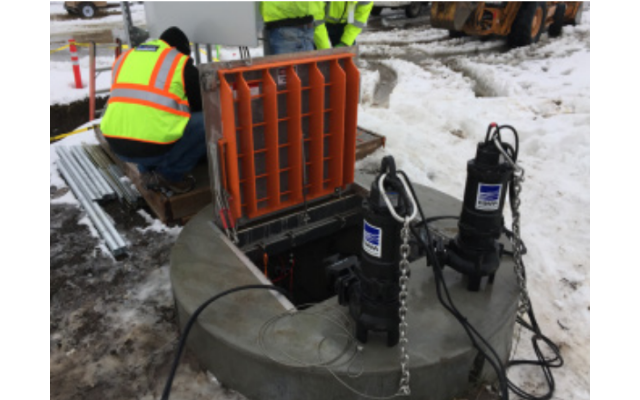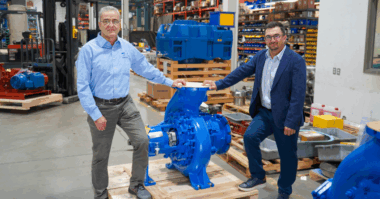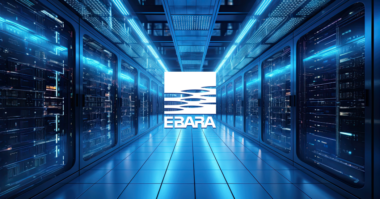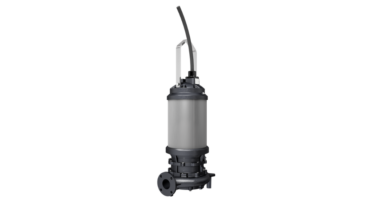Contributor: EBARA Pumps Americas Corporation
It is often asked, “What can operation and maintenance personnel do to extend the life of a submersible centrifugal pump?” While maintenance and operating personnel have a lot to do with the service life of a submersible centrifugal pump, they only affect approximately 50% of the considerable factors.
There are two key elements that will impact life expectancy of the pumps before maintenance personnel even have access. Pump selection and project design, along with proper installation of the equipment are both essential to ensure the pumps success.
Pump Selection
Pump selection is a major key in the life expectancy of a submersible centrifugal pump.
Top factors to consider when initially selecting your pump include:
- The initial pump design
- Expected performance of the pump
- The number of pumps required for initial install
- The sequencing of the pumps
- Whether or not the system manifolded with other systems
- Products interconnected to the pumping system and other necessary equipment
- Voltage types
- Motor protection devices
All these items and more play a significant part of the life expectancy of the pumping equipment. With all these items being carefully evaluated, proper installation can play a large role in the extended life of a submersible centrifugal pump.
Installation
It is important to evaluate how the initial contractor installed the projects, as well as the plans and specifications. Those plans can allow us to see needed changes such as easements needing to be made due to path changes to the force main and how those could have affected the overall pumping system. Not only that, but the need for pressure gages and making sure they were proper installed.
Environmental issues surrounding the pump system installation can affect the life expectancy. One major environmental consideration is in sandy/gritty soil. The introduction of sand/grit in a pumping application tends to wear rotating parts more quickly than in non-sandy/gritty soils.
The overall piping installation will also affect the life expectancy of the equipment. Has proper care been taken to install the piping correctly? Have air release valves been properly installed in all the high spots of the piping system?
Starting up the equipment is the final part of the installation process. This allows for confirmation of proper voltage, pump rotation, and general functionality of the station. Once completed, record start-up procedures, control panel voltage, amps etc. to establish a base line of pump operation. Verify all motor protection devices are properly hooked up. Lastly, ensure proper installation of all parts.
General Maintenance
As operations and maintenance personnel take over their new pumping systems, they will have to determine what is the required general maintenance to ensure long and trouble-free operation of their equipment. General/ Routine maintenance will vary from manufacturers and the type of equipment, but here are recommended maintenance measures:
Routine Maintenance
- Daily – Perform routine inspection such as leak checks, vibration analyses, temperature and discharge pressure inspections, and oil level and condition checks.
- Monthly/Quarterly – Perform monthly and/or quarterly maintenance to ensure pumps are bolted down tightly, mechanical seals are intact, shaft alignments are properly placed, and ensure oil is not contaminated/needing to be replaced. Verify manufacturer’s recommended clearances between wear surfaces, and correct clearances if they are outside recommended dimensions.
- Annually – Every year, check the pump capacity, pressure, and power. Compare the performance of these indicators to the requirements of your process. If the performance does not line up, you’ll need to disassemble the pump, inspect it thoroughly, and replace necessary worn parts.
Maintenance Types 101
- Preventative Maintenance – Maintenance that is regularly performed on a piece of equipment to lessen the likelihood of it failing. It is performed while the equipment is still working so that it does not break down unexpectedly.
- Predictive Maintenance – A technique that uses condition-monitoring tools and techniques to track the performance of equipment during normal operation to detect possible defects and fix them before they result in failure
- Reactionary Maintenance – This refers to repairs that are done when equipment has already broken down, in order to restore the equipment to its normal operating condition.
- Continuous Diagnostic Maintenance – The process of monitoring a parameter of conditions in machinery (vibration, temperature etc.), in order to identify a significant change which is indicative of a developing fault. The use of condition monitoring allows maintenance to be scheduled, or other actions to be taken to prevent consequential damages. Condition monitoring helps to address issues that would shorten the lifespan of equipment. These techniques are normally used on rotating equipment, auxiliary systems and other machinery such as compressors, pumps, electric motors, internal combustion engines and presses.
- Historical Maintenance – Utilizing a chronological list of all maintenance performed on a piece of equipment and scheduling maintenance based on the historical data to try to maintain the equipment prior to a failure at a documented time frame.
OEM Parts
The use of OEM parts is essential for extending the life of a submersible centrifugal pump. Some of the key reasons to utilize OEM parts involve manufacturer warranty, specs and tolerances being met, material shelf life, and to avoid inaccurate copies of original parts.
Not utilizing OEM parts could potentially void the manufacturer warranty. It could also affect the specs and tolerances of the pump due to the parts not perfectly aligning together. Non-OEM parts are usually copies of an original part. When a copy is made, it could be made from a used/worn part, the improper version, or be made with a different material than the original manufacturer.
Although Non-OEM parts have the allure of costing less, that could only be a short-term expense. Long-term, there is potential for those parts to cause other complications, requiring more maintenance and expenses over the lifetime of the equipment.
Conclusion
In order to properly extend the life of a submersible centrifugal pump, it is essential that proper steps are taken. Proper installation, routine maintenance, and the utilization of OEM parts are necessary for the health and overall functionality of the pump. Need help with extending the life of your centrifugal pump? Give one of our experts a call!
https://empoweringpumps.com/ebara-receives-2019-supplier-achievement-award-saa-from-intel-corporation-us/




